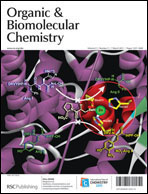A series of modified nucleosides based on thymidine have been prepared by Pd-catalysed cross-coupling between N-alkyl-alkynyl functionalised pyrrolyl- (py), 2-(2-thienyl)pyrrolyl- (tp) or 2,5-bis(2-thienyl)pyrrolyl (tpt) groups with 5-iodo-2′-deoxyuridine. The length of the alkyl chain linking the nucleoside and pyrrolyl-containing unit, N(CH2)nC![[triple bond, length as m-dash]](https://www.rsc.org/images/entities/char_e002.gif) C-nucleoside (where n = 1–3) was also varied. The compounds have been characterised by 1H NMR, ES-MS, UV–vis, cyclic voltammetry (CV) and, in some cases, single-crystal X-ray diffraction. Cyclic voltammetry studies demonstrated that all the py-, tp- and tpt-alkynyl derivatives 1–7 can be electrochemically polymerised to form conductive materials. It was found that increasing the N-alkyl chain length in these cases resulted in only minor changes in the oxidation potential. The same behaviour was observed for the tp- and tpt-modified nucleosides 9–12; however, the py-derivative, 8, produced a poorly conducting material. DFT calculations on the one-electron oxidised cation of the modified nucleosides bearing tp or tpt showed that spin density is located on the pyrrolyl and thienyl units in all cases and that the coplanarity of adjacent rings increases upon oxidation. In contrast, in the corresponding pyrrolyl cases the spin density is distributed over the whole molecule, suggesting that polymerisation does not occur solely at the pyrrolyl-Cα position and the conjugation is interrupted.
C-nucleoside (where n = 1–3) was also varied. The compounds have been characterised by 1H NMR, ES-MS, UV–vis, cyclic voltammetry (CV) and, in some cases, single-crystal X-ray diffraction. Cyclic voltammetry studies demonstrated that all the py-, tp- and tpt-alkynyl derivatives 1–7 can be electrochemically polymerised to form conductive materials. It was found that increasing the N-alkyl chain length in these cases resulted in only minor changes in the oxidation potential. The same behaviour was observed for the tp- and tpt-modified nucleosides 9–12; however, the py-derivative, 8, produced a poorly conducting material. DFT calculations on the one-electron oxidised cation of the modified nucleosides bearing tp or tpt showed that spin density is located on the pyrrolyl and thienyl units in all cases and that the coplanarity of adjacent rings increases upon oxidation. In contrast, in the corresponding pyrrolyl cases the spin density is distributed over the whole molecule, suggesting that polymerisation does not occur solely at the pyrrolyl-Cα position and the conjugation is interrupted.

You have access to this article
 Please wait while we load your content...
Something went wrong. Try again?
Please wait while we load your content...
Something went wrong. Try again?
![[triple bond, length as m-dash]](https://www.rsc.org/images/entities/char_e002.gif) C-nucleoside (where n = 1–3) was also varied. The compounds have been characterised by
C-nucleoside (where n = 1–3) was also varied. The compounds have been characterised by 

 Please wait while we load your content...
Please wait while we load your content...